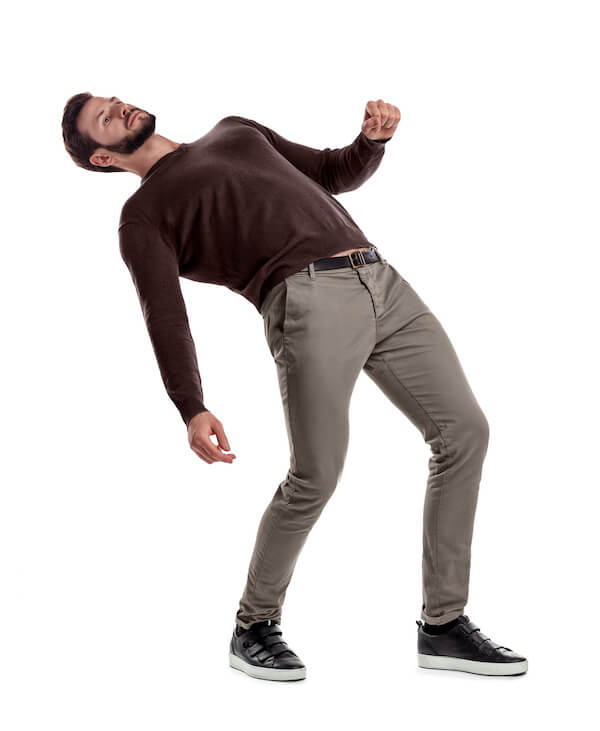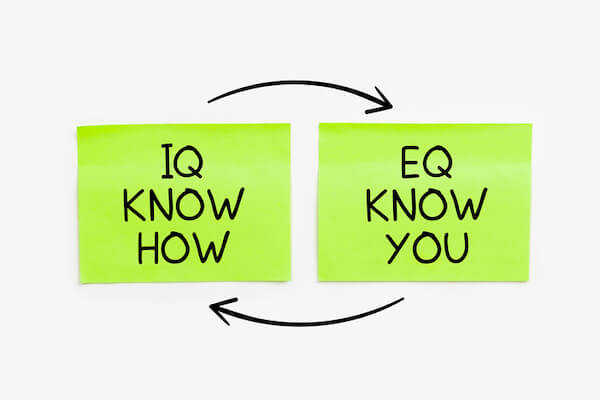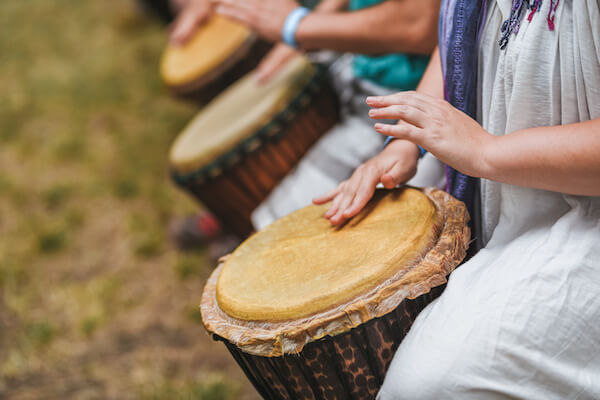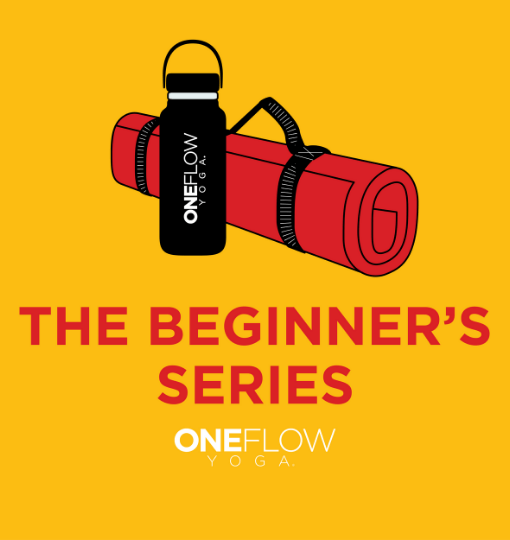Based on my personal observation of tens of thousands of students and knowledge of the science involved, crying in yoga is normal. But so is feeling angry, sad, joyous, or any other type of emotion. The true question is, why does yoga make you cry and feel emotional?
You cry, get angry, and feel good in yoga because of its characteristic movement, breath, and rhythm. Yoga uses tension and release and introduces novelty to process, unwind and change long-held patterns of feeling and emotion, including fear, sadness, and anxiety.
Yoga is the antithesis of the modern world which can be rushed and alienating. Instead, yoga invites you back to your humanity, which includes not only your body, or physical self, but you as an emotional being.
Emotions are a kind of superpower, even if they are more often dismissed.
Without emotions, you could not make a simple decision, such as whether to use a blue or black pen. We know this from the work of Antonio Damasio, a neuroscientist studying decision-making and the effects of emotional impairment. He explains this in his book Descartes’ Error: Emotion, Reason, and the Human Brain.
The irony is, while today we prize logic, reason, and the mind, you need full access to your emotions to move successfully in the world.
Yoga can help you not only feel more but help you heal deeply embedded emotions that may be holding you back. If you can cry, feel your sadness, or any other emotion, you can also experience your joy.
There are several ways yoga helps you do this.
How ’bout unabashed bawling your eyes out?
Alanis Morissette
The Movement of Yoga Makes You Cry and Invites Feeling
Yoga is known as a movement or physical practice. It’s yoga postures, also called yoga asana, bend, stretch and move you in various ways.
These movements make you stronger, more flexible, and resilient. They also have the added benefit of releasing tension and emotion. And with that release often come tears, though not always. For some people, letting go might look like laughter or anger.
But why does this happen?
To make it through life daily, we subconsciously guard. We contract different parts of our body, almost like putting on emotional armor. This can be helpful in that you can get a lot done without feeling and dealing with internal sensations all the time.

Emotions Get Stuck
But the constant contractions can become problematic because they can become stuck. We literally hold ourselves so tightly that we cannot move, and thus cannot feel.
Intuitively you know this when you talk about where you hold your tension, such as your neck, jaw, or shoulders.
When I was training to be a yoga teacher, we had a cadaver lab. I saw firsthand how muscles that should slide back and forth, like our rhomboids, can get stuck in place. Yoga helps to release the adhesions and bring freer movement. And with that comes feeling, and yes, crying.
It’s similar to how permafrost, the thick ground frozen year-round, captures carbon and keeps it held in a suspended state. When the ground warms up and melts, it reverses the process and releases carbon back into the atmosphere.
Going through a yoga practice literally warms your body up and moves you to release often buried emotions.
Vinyasa Yoga and Novelty
Vinyasa yoga is particularly effective at helping you feel because it is a variable style of practice.
This means no two sessions are alike. Your body will be invited to move in numerous ways each time you are on the mat.
Novelty is the opposite of habit. Vinyasa yoga sequences and poses are often unpredictable and unfamiliar, giving them a way to circumvent your typical guarding response.
Take backbends, for instance. In our day-to-day lives, we have a habit of folding forward, like when we drive, text, or type. But we never bend backward.

This is one of the reasons backbends are sometimes called “heart openers.” A posture like bridge, Setu Bandha Sarvangasana, can release the old pattern of folding forward and expose the emotions that lie dormant in a way that feels like opening your heart.
Likewise, the grouping of poses that can loosely be called hip openers takes your hips through a range of motion. This stands in contrast to the sitting posture we adopt for long periods of each day. Your hips just need some playtime to feel good again.
Tension and Release
Yoga is a dynamic back and forth between tension and release. The act of tensing your muscles, as when you hold a yoga pose, can allow a more significant release. This is referred to as progressive muscle relaxation.
Again, when we release, let go, surrender, relax, and open, there is the possibility of bawling in the best sense.
The Role of Stress
In yoga, there is work to do. It’s going to require effort. However, stress, often in the form of muscular action, can benefit you by rebalancing you.
People often have negative connotations regarding stress, as if all stress is bad. However, you can have too little stress in your life, as well as too much. The sweet spot is called eustress, the place in between that can create well-being.
I mention this because whatever we do to the body, we also do to the mind and emotions. This is one of the reasons why yoga works.
Massage therapists know this and speak about how “the issues are in the tissues.” And just like in yoga, it’s not uncommon to cry on the massage table. Why? Because they are moving your body and thus moving you.
It’s why it feels so good to go for a run or bike ride because you are moving not only your legs but your feelings.
Yoga differs from other forms of exercise because it has a philosophy to help you deal with feelings.
Learn to Breathe, And You’ll Experience Tears
Max Strom is a noteworthy yoga teacher and author of A Life Worth Breathing. He shares in that book how no one told him about crying. However, later, he found a teacher that understood the prevalence of emotion.
“When you learn to breathe well, at times you will inevitably experience tears.”
Max Strom
When the tears come, I find they typically last about a year. It’s like this repository of emotion we commonly call “baggage” takes time to unwind, feel and go through.
But there’s no rush. Instead, in typical yoga fashion, it takes as long as it takes.
Ujjayi Breathing
Breathing in and out through your nose, rhythmically, or what we call Ujjayi Breath, relaxes you. It’s one of the primary reasons why we use it.
This is a paradox, as what we’re trying to do with yoga postures is create tension through muscle activation but then relax in that tension. Ujjayi helps with the latter.
This creates an unusual place where you can both experience and engage your emotions. You can do yoga.
In the beginning, our feelings and responses in yoga are often involuntary. That’s why we burst into tears for no apparent reason. However, if you keep at it, you can start to witness how your emotions work. You can see them as a seed before they grow, watch them spread, and even notice how you can juice or quell them.
You become a participant in your emotions rather than having them become something that happens to you. As a result, your feelings inform rather than overwhelm you.
Yoga calls this awareness or buddhi.

Emotional Intelligence
In psychology, awareness is part of a bigger idea known as emotional intelligence.
“Emotional intelligence is the ability to perceive emotions, to access and generate emotions so as to assist thought, to understand emotions and emotional knowledge, and to reflectively regulate emotions so as to promote emotional and intellectual growth.”
Mayer & Salovey, 1997, developers of Emotional Intelligence as a Psychological Theory
Yoga is a way for you to access, understand and use your emotions. Breath, and more specifically, Ujjayi Breath, is how you access them.
Early yoga imagined we could be sovereign over our emotions–what they called raja or royal yoga. Raja also means command, control, and discipline. The thought was you could control your feelings entirely. Too often, though, that leads to shutting down emotion, which many of us do in response to the modern world.
We guard, shut down and protect. And in turn, we shut ourselves off from our feelings to our detriment.
A better way is to learn to be with your emotions. This is the essence of emotional intelligence (EQ).
But how do you learn to work with your emotions?
Practice yoga.
“If you want to manage your emotions better, your brain gives you two options: You can learn to regulate them from the top down or from the bottom up…Top down-regulation involves strengthening the capacity of the watchtower to monitor your body’s sensations. Mindfulness meditation and yoga can help with this. Bottom-up regulation involves recalibrating the autonomic nervous system…We can access the ANS through breath, movement, or touch.”
Bessel Van Der Kolk, M.D. The Body Keeps The Score
Technically yoga is both top-down and bottom-up because it involves awareness, movement, and breath. Yoga teaches you how to bring feelings up, watch them, and learn from them.
Van der Kolk also published a study in the Journal of Clinical Psychiatry showing how yoga can affect PTSD. This builds on other scientific work that shows how changing your breathing can improve anger, depression, and anxiety.
Relaxation
As vinyasa yoga teachers, we talk about the arc of the class. A yoga class will start by transitioning you out of your day and onto the mat.
This might be a quiet moment or a place where we do forward folds for safety and reflective purposes. Then we begin the work of warming up.
The work begins and builds until you reach an apex of the class.
This arc is often denoted as a mountain. When you get to the top of the mountain, you don’t want to just jump off. You want to come down gradually. It’s not a great idea to drop into the final resting pose, savasana, but instead, glide in prepared.
I mention all of this because you can think of the first three-quarters of class as tension. After that, the last quarter moves you towards further states of relaxation.
It is here you are most likely to cry and emote.
It’s as if you’ve allowed your standard guarding patterns to exhaust, and now you can relax into yourself.
And it’s important to note this isn’t always a conscious matter, at least initially. If you take yourself through the process of yoga regularly, feelings will come up because you’re adorably human. Thank goodness.
But now you know this is normal and that your emotions are an ally when you befriend them.

Rhythm Is A Dancer That Makes You Cry With Joy
Rhythm is a dancer
It’s a soul’s companion
You can feel it everywhere
Snap!
Rhythm is one of the hidden tools of vinyasa yoga.
To see if it’s hidden where you practice yoga, notice if the class is moving together. A skillful vinyasa yoga class will move as one.
There are times and reasons not to have the class in sync. However, when vinyasa is at its best, the class is together.
In her book Dancing in the Streets, Barbara Ehrenreich argues that moving together rhythmically is a primal human activity that brings us closer as a community and invokes joy.
Flowing together and feeling the rhythm involves a give and take that connects us to others and ourselves.
Other Reasons You’ll Feel Emotional in Yoga
Time And Space to Feel
You’re busy. Often too busy to feel. And even if you weren’t, would you make time to notice your feelings?.
I’m betting maybe not.
But with yoga, you get to do something “productive,” like build strength and flexibility, and you get the emotional benefit to boot.
And feelings, tears, et al., can come up because you have the time and space for them.
It’s like going on vacation, sitting on the beach, and letting out a big exhale.
Often I can go through my entire day, taking care of kids, running a business, paying bills, etc. It’s not until I get to my mat that I begin to notice how I feel.
Suppose there was an interaction with a colleague or my partner earlier. Sometimes I discover I hadn’t fully processed what came up for me in the moment because I didn’t have the time. When I get to the mat, I realize I have been carrying it around, and now I can be with it and even let it go.
The mat is a safe space to feel, think and reflect.
Safe Space
Ideally, a yoga class is a safe space. For this purpose, it can be helpful to practice in a vetted yoga studio.
I see people enter our studio all the time as if they are taking cover from fire. They often say something like, “thank god I’m here.”
This is the one place where nothing is expected of them. There are no kids, board meetings, or homework. It’s just them, their thoughts, and their breath.
Given that, it’s not unusual that tears manifest.
Paying Attention
Again, other emotions can come up, like sadness or anger.
What happens when you feel anger?
It’s not as simple as letting it go away.
Yoga invites you to pay attention to a feeling, label it and reflect on it. For example, the practice will show you where anger can lead and help you realize when it’s helpful.
From time to time, you need your anger, but often it can consume you. The key is realizing if anger is helpful.
This may be shocking because many people think yoga is all about being calm. On the contrary, yoga is more about understanding energy and learning how to channel it. Your emotions are energy you can use.
Sometimes, the best reaction, such as when you see injustice or unfairness, is getting upset, getting fired up, and doing something.
The same is true of sadness. If you’ve experienced a loss, you will probably benefit from a period of grieving and sorrow.
6 Tips to Work with Emotions In Yoga
1–Being Emotional Is Normal
Realize connecting to your emotions and even crying is normal.
2–Feel Your Feelings
Yoga teachers often enjoin you to “feel your feelings.” That’s a bit loaded because many of us are only painting with five or six colors on the emotional palette when a multitude is possible.
Interoception, or knowing how you feel, is inherently vulnerable and is an asset.
Getting to know your feelings will help you connect not only with yourself but others. We call this empathy. And don’t be afraid to label your emotions. Labeling lets you take your power back.
One more thing. I often advise students to be aware of their emotions in the days following their practice. Just because we stir things up in one yoga session does not mean they will resolve there.
3–Go Slow
People think of yoga as an everyday practice because of its physical nature. However, it’s more about putting yourself through a process frequently. Since you’ll be practicing regularly–defined as 3-5 times a week, every week, you have plenty of time to sift through your feelings.
Remember, yoga is always a “go at your own pace” activity. You get to decide how much you feel.
Likewise, you may try to go faster and find nothing comes up. Yoga is a practice of little by little. This applies to all of us but especially if you experience anxiety.
4–Keep Practicing
Repetition is vital in yoga.
I think of emotional work as excavation. Archeologists often start with earth-moving equipment, then shovels, and finally brushes.
What else is there? If you have a backlog of emotion, it’s going to take a decade if you practice infrequently. A persistent practice will uncover the layers of feeling at a faster pace.
5–Act Or Not
Sometimes our feelings can inspire us to act and make a change in our lives.
However, often the act of feeling, labeling, and reflecting is enough for the emotion to subside. It’s as if you’ve put yourself through the process of yoga, and the emotion has become vapor that wafts away.
“If he invites us to stay, then we’ll go”
Butch Cassidy and Sundance Kid
Befriend your emotions, especially those you perceive as negative, and often they’ll go.
6–Maintenance
After you’ve done the work of processing your stockpile of emotion, that doesn’t mean it’s over.
Now you move into the maintenance phase because stuff will build up again, even once you feel better. Because you are still moving in the world and so things will continue to come up.
But now you have yoga, a way to deal with whatever comes up in your daily life.



